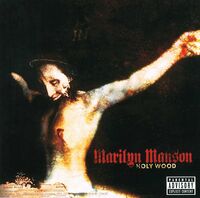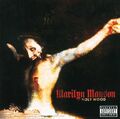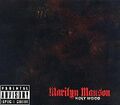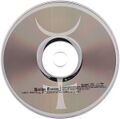Holy Wood (In the Shadow of the Valley of Death)
- This article is about the album. For other uses, see In the Shadow of the Valley of Death and Holy Wood (novel).
| Holy Wood (In the Shadow of the Valley of Death) | |||||
|---|---|---|---|---|---|

|
|||||
| Studio album by Marilyn Manson | |||||
| Released | November 13, 2000 | ||||
| Recorded | 1999–2000 at the Mansion in Death Valley, California | ||||
| Genre | Alternative metal, heavy metal, industrial metal | ||||
| Length | 68:19 | ||||
| Label | Nothing, Interscope | ||||
| Producer | Marilyn Manson, Dave Sardy | ||||
| Professional reviews | |||||
|
|||||
| Analysis and Interpretations | |||||
|
The Third And Final Beast (Nachtkabarett) |
|||||
| Marilyn Manson chronology | |||||
|
|||||
Holy Wood (In the Shadow of the Valley of Death) is the fourth full-length album by rock band Marilyn Manson. It was released on November 13, 2000 by Interscope Records. It is a concept album, and the third and final album of a trilogy along with Antichrist Superstar and Mechanical Animals. It spawned three singles ("Disposable Teens", "The Fight Song" and "The Nobodies") and a novel which remains currently unreleased.
Additionally, as with Antichrist Superstar and Mechanical Animals, the album was released with a cardboard sleeve featuring alternate artwork due to some retailers refusing to stock the album with the original artwork portraying Manson in a crucified pose with a missing jaw. Manson described the move as "censorship" and stated that "those offended by my album cover have successfully proven my point [with the image]."[1]
Contents
Origin and recording
The album's conception and gestation was marked by the singer's three month seclusion at his then home in the Hollywood Hills following the Columbine High School massacre (April 20, 1999), vacillating on "what I was going to do and how I was going to react"[2]. This was then followed by a year of recording and refining the album.[3]. The singer has claimed that "over 200 songs" had been written during this album's production though only 19 made it into the final product. "Diamonds & Pollen" remains the only outtake to be released from the Holy Wood sessions, though low quality snippets of "Jack Eats Dinner" and "Compass and the Ruler" were released in a podcast by the band.
Concept
- for a complete overview of the Trilogy see Triptych.
Holy Wood was Marilyn Manson's first album since the Columbine tragedy and the ensuing moral panic, for which the musician and the band served as a scapegoat[4][5], being held culpable by various media outlets, religious figures, pundits, civic groups[6] and politicians who recklessly made sensationalist allegations that the band's music and imagery drove Eric Harris and Dylan Klebold to kill their classmates[7] despite later reports to the contrary; that the two even despised their music[8][9]. Consequently, much of the album's content addresses the issue and articulates on American society's common obsession with firearms, religion, and media martyrs by appropriating criticism on what he sees as the three core preoccupations of Conservative Christian America, "Guns, God and Government"[10]. He also criticizes parents and the news media for the more harmful roles they play in the glorification and acceptance of wholesale violence into the "mainstream" in comparison to music, movies, books or video games[11][12].
To this end, the album heavily allegories events and figures in pop culture history which has gone on to define America itself, utilizing its implications and ramifications in the intent of contextualizing Columbine in a wider cultural perspective. A great number of these references draw from the far-reaching impact of the tumultuous decade of the 1960's and 1970's[13] such as Abraham Zapruder's film of the Kennedy Assassination (especially Frame 313), Aldous Huxley's less publicized death on the same day, the "Winter of Discontent" (and its resolution on Valentine's Day), the Altamont Free Concert tragedy which not only brought an abrupt and violent end to the 'love generation' but also cemented America's fear of its own children, The Beatles' White Album and the Charles Manson murders[14]. The latter two is especially significant with regards to the larger issue of whether life imitates art since the White Album was thought to have played a role in the case when news media reported that the murders may have been inspired by Charles Manson's misreading of the record, resulting in the formation of his infamous Helter Skelter manifesto. In this sense, Marilyn Manson draws similarities between Holy Wood and the White Album; not only in that both him and it have been used as an easy scapegoat by a traumatized, knee-jerk reactionary American public but also as both expounds on America's obsession with guns and violence and addresses the political concepts of evolution and revolution[15]. He further identifies with Lennon by re-appropriating lyrics from "Revolution 1" in "Disposable Teens" and "Across the Universe" in "Lamb of God". More critically, however, Manson places a spotlight on the universal phenomenon of famous people being 'canonized' by the press into "martyrdom" by the extensive coverage of their tragic deaths, on TV or print, throughout history resulting in cult-of-personality celebrity worship by the people. He cites examples of such American assassination icons as John F. Kennedy (mentioned by his nickname "Jack" throughout the record), John Lennon and Jesus Christ[16]. Of the latter's crucifixion he opines,
- "We definitely live a culture that worships sex and violence. We even hang such images above our doors and around our necks. The image of Christ dying on the cross is very violent. It's very sexual...very phallic. The crucifix [also happens to be] the most successful piece of merchandise ever created. In a lot of ways it's like a concert T-shirt. [It] has turned Christ [into] the first rock star [and yet] the crucifix will always be considered holy. But think of how many people [have been killed] in the name of that image."
- -Marilyn Manson, Marilyn Manson: The Beliefnet Interview (2001)[17]
Within Marilyn Manson's album trilogy[18], Holy Wood serves as prequel[19] to Mechanical Animals and Antichrist Superstar despite the two latter albums preceding Holy Wood in release date[20]. It is worth noting that each album contains its own storyline and protagonist distinct from each other but are also linked together abstractly in a fourth larger storyline encompassing all three albums[21]. Each album, as well as the whole, has been written to be deliberately vague so that listeners can draw their own conclusions, however, Manson has offered this much in the way of an interpretation,
- "[Holy Wood is about] wanting to fit into a world that didn't want me, and fighting really hard to get there. [The album's deepest elements] are idealism and the desire to start a revolution. If you begin with Holy Wood, then Mechanical Animals really talks about how that revolution gets taken away from you and turned into a product, and then Antichrist Superstar is where you're given a choice to decide if you're going to be controlled by the power that you created or if you want to destroy yourself and then start over. It just becomes a cycle."
- -Marilyn Manson, Guns, God and Government: Interview with Marilyn Manson[22]
A major literary device utilized by the album is the song cycle structure also seen in Antichrist Superstar. Here, there are four which form the framework of the storyline: A: In the Shadow, D: The Androgyne, A: Of Red Earth and M: The Fallen.
The backdrop of Holy Wood's storyline revolves around the two duelling regions of "Holy Wood" and "Death Valley". Its protagonist is "Adam Kadmon", an abstract character borrowed from the Kabbalah where he is described as the archetype for humanity and the first Adam from which every soul is descended[23]. He is an outsider and anti-hero from Death Valley threading his way through Holy Wood. His disgust at what he sees and experiences leads him to attempt a revolution through music in order to bring down Holy Wood but his sojourn soon goes awry when his revolution is exploited by society[24][25]. It is notable that the tragic and ill-fated character Coma White (from Mechanical Animals), which Adam has a quasi-romantic interest for, is referred to on this album as "Coma Black"[26]. At the conclusion of the record, a defeated and disillusioned Kadmon is on the verge of suicide and can be heard playing Russian roulette with a revolver. His fate is deliberately left unknown after the fifth cock of the pistol[27].
Reception
Holy Wood received both mixed reviews from critics:
- Rolling Stone said: "The band truly rocks: Its malevolent groove fleshes out its leader's usual complaints with an exhilarating swagger that's the essence of rock & roll."
- Allmusic said: "There's so much effort, Holy Wood winds up a stronger and more consistent album than any of his other work."
- PopMatters said: "The central flaw of Holy Wood is that the power of its message, an important and provocative one, is watered down by its artistic pretensions. While Holy Wood is often affecting, it would be a better album if it was shorter and dealt with its subject matter directly, instead of through the veil of the 'concept album'."[28]
- NME said: "Manson's comparison of 'Holy Wood...' with 'The White Album' is rather rich, considering that it's basically an elaborate consolidation of ideas he's already explored. [Nevertheless] 'Holy Wood...' puts Manson's critics and second division nu-metallers like Korn and Slipknot firmly in their place."[29]
In the United States it debuted and peaked at No. 13 on the Billboard 200. In the weeks that followed, it quickly fell off the charts. It was later awarded gold status for selling more than 500,000 copies in March 2003[30]. The commercial failure of this album can be attributed to waning interest in Manson's "shock rock" tactics, to which the public had become habituated at this point.
Book and film
- See also Holy Wood (novel) for more details
The album was originally to be accompanied by a book and a film of the same name which were to further explore the album's backstory[31]. In an interview with Manson in December 2000, Chuck Palahniuk briefly mentions the book and compliments its style, adding it is due for release "next spring"[32]. The book has yet to be released, allegedly due to a publishing dispute, and the film never began production.
Track listing
A: In the Shadow
- 1. "GodEatGod" – 2:34
- 2. "The Love Song" – 3:16
- 3. "The Fight Song" – 2:55
- 4. "Disposable Teens" – 3:01
D: The Androgyne
- 5. "Target Audience (Narcissus Narcosis)" – 4:18
- 6. ""President Dead"" – 3:13
- 7. "In the Shadow of the Valley of Death" – 4:09
- 8. "Cruci-Fiction in Space"' – 4:56
- 9. "A Place in the Dirt" – 3:37
A: Of Red Earth
- 10. "The Nobodies" – 3:35
- 11. "The Death Song" – 3:30
- 12. "Lamb of God" – 4:39
- 13. "Born Again" – 3:20
- 14. "Burning Flag" – 3:21
M: The Fallen
- 15. "Coma Black: a) Eden Eye, b) The Apple of Discord" – 5:58
- 16. "Valentine's Day" – 3:31
- 17. "The Fall of Adam" – 2:34
- 18. "King Kill 33°" – 2:18
- 19. "Count to Six and Die (The Vacuum of Infinite Space Encompassing)" – 3:24
Bonus tracks
- 20. "The Nobodies" (Acoustic Version) (Bonus track on UK and Japanese versions) – 3:33
- 21. "Mechanical Animals" (live) (Bonus track on Japanese version) - 4:41
B-sides
- "Diamonds & Pollen" – 3:55
- "Five to One" (The Doors cover) – 4:22
- "Working Class Hero" (John Lennon cover) – 3:42
Autopsy
A short film known as Autopsy could be viewed by running a "START.exe" program included in the disk (in the same way one would run a similar program to listen to the hidden track "Untitled" on the previous album Mechanical Animals. While the video, in which a dead Manson has a fetus removed from his skull during autopsy, was originally hosted on the Interscope website it is no longer featured there and can only be viewed as an easter egg on the Lest We Forget (The Best of) bonus DVD.
Album credits
ALL LYRICS BY M. MANSON ·· 1. (music: MANSON) keyboards and bass · synth: Manson · Vocals: Manson · Guitars: John5 · Lead guitar: T. Ramirez · Ambience: M.W. Gacy · Synth: Bon Harris · Noise rhythm guitar: Dave Sardy ·· 2. (music: RAMIREZ., 5) Vocals and ouro-lead guitar: Manson · Guitar and Bass: T. Ramirez · Guitars: John5 · Keyboards and samples: M.W. Gacy · Live drums and siren loop: Ginger Fish · Synth and drum programming: Bon Harris ·· 3. (music: 5) Vocals: Manson · Bass and additional guitar: T. Ramirez · Rhythm and lead guitar: John5 · Keyboards and loops: M.W. Gacy · Live drums: Ginger Fish ·· 4. (music: 5, RAMIREZ) Vocals: Manson · Bass: T. Ramirez · Guitar and synth guitar: John5 · Synth and electronic percussion: Bon Harris · Live drums: Ginger Fish · Keyboards: M.W. Gacy · Pills: D. Sardy ·· 5. (music: RAMIREZ, 5) Vocals and Optigan: Manson · Bass and additional lead guitar: T. Ramirez · All guitars: John5 · Loop and live drums: Ginger Fish · Synth and loops: M.W. Gacy · Drum programming and synth: Bon Harris ·· 6. (music: RAMIREZ., 5, GACY) Vocals, syncussion, and mellotron: Manson · Rhythm Guitar and bass: T. Ramirez · Lead and rhythm guitar: John5 · Loop and live drums: Ginger Fish · Keyboards: M.W. Gacy · Backing Vocals: Alex Suttle ·· 7. (music: RAMIREZ., 5) Vocals and distorted flute: Manson · All Keyboards: M.W. Gacy · All guitars: John5 · Death Loop and live drums: Ginger Fish · Bass: T. Ramirez ·· 8. (music: RAMIREZ., 5, GACY) Vocals and piano: Manson · Rhythm guitar, bass: T. Ramirez · Rhythm and lead guitar: John5 · Live drums: Ginger Fish · Keyboards, loops and ambiences: M.W. Gacy · Insect hi-hat: Bon Harris ·· 9. (music: 5) Vocals and Ambience: Manson · Synth bass and keyboards: M.W,. Gacy · Live drums and loop: Ginger Fish · Bass: T. Ramirez · Acoustic, electric and slide guitars: John5 · Synths, sleigh bells and manipulation: Bon Harris ·· 10. (music: 5, MANSON) electric harpsichord: Manson · Guitars: John5 · Bass: T. Ramirez · Keyboards and ambiences: M.W. Gacy · Drum machine and live kit: Ginger Fish · Vocals: Manson ·· 11. (music: 5, MANSON) Vocals: Manson · guitars: John 5 · Bass: T.Ramirez · Synth bass and electronics: Bon Harris · Loop and live drums: Ginger Fish · Children's choir and canned laughter of dead people unsure of why they are laughing: M.W. Gacy ·· 12. (music: RAMIREZ.) Vocals, piano and pianette: Manson · Bass, lead and Leslie guitar, keys and drum loop: T. Ramirez · Acoustic, rhythm and lead guitar: John5 · Live drums: Ginger Fish · Ambience: M.W. Gacy · Synths: Bon Harris ·· 13. (music: RAMIREZ., 5) Vocals and synth bass: Manson · Bass and verse guitar: T. Ramirez · Guitar and lead guitar: John5 · Keyboards: M.W. Gacy · Drum Programming: Ginger Fish and Bon Harris · Bass and other synths: Bon Harris · Additional loops: Danny Saber · Recorded live February 14, 1997 ·· 14. (music: RAMIREZ., 5) Vocals: Manson Guitar and bass: T. Ramirez · Guitar: John5 · Live drums: Ginger Fish · Organic drum programming: Bon Harris and D. Sardy · Synth and destructive manipulation: Bon Harris · Keyboards: M.W. Gacy ·· 15. a)(music: MANSON, 5, RAMIREZ.) Vocals and clean rhythm guitar: Manson · Bass, warped rhythm guitars and add. lead: T. Ramirez · Phase, lead and rhythm guitar: John5 · Loops and live drums: Ginger Fish · Synths, ambience and keyboards: M.W. Gacy · b)(music: MANSON) Vocals and clean guitar: Manson · Rhythm Guitar: John5 · Bass and lead guitar: T. Ramirez · Loop: Ginger Fish ·· 16. (music: RAMIREZ., MANSON) Vocals and piano: Manson · Bass and noise lead guitars: T. Ramirez · Loop and live drums: Ginger Fish · Lead and rhythm guitars: John5 · Keyboards and mellotron: M.W. Gacy · Synthesizers: Bon Harris ·· 17. (music: RAMIREZ., 5) Vocals: Manson · Acoustic, rhythm and synth guitar: John 5 · Bass and rhythm guitar: T. Ramirez · Live drums: Ginger Fish ·· 18. (music: RAMIREZ) Vocals: Manson · Bass: T. Ramirez · Guitars and synth guitars: John5 · Keyboards and Synth: M.W. Gacy · Live drums: Ginger Fish ·· 19. (music: 5) Vocals: Manson · Synth strings and Ambiences: M.W. Gacy · Piano: Bon Harris ····· Celebritarian™ used by permission
···ALL TRACKS ©2000 EMI BLACKWOOD MUSIC ON BEHALF OF ITSELF, SONGS OF GOLGOTHA MUSIC (BMI), BLOOD HEAVY MUSIC (BMI) & DCLXVI MUSIC (BMI). ALL RIGHTS ADMINISTERED WORLDWIDE BY EMI BLACKWOOD MUSIC INC. · MANSON: ALL TRACKS, SONGS OF GOLGOTHA MUSIC · RAMIREZ: ALL TRACKS, BLOOD HEAVY MUSIC, EXCEPT 1, 3, 9, 10, 11, 15b, 19 · JOHN 5: ALL TRACKS, GTR. HACK MUSIC / CHRYSALIS MUSIC ASCAP, EXCEPT 1, 12, 15b, 16, 18 · GACY: TRACKS 6 & 8 DCLXVI MUSIC ©2000 NOTHING/INTERSCOPE RECORDS. ALL RIGHTS RESERVED. PRINTED IN CANADA.
HOLY WOOD CONCEIVED AND ARRANGED BY MARILYN MANSON
PRODUCED BY MARILYN MANSON & D. SARDY · MIXED BY D. SARDY
ENGINEERED BY GRED FIDELMAN · ALL PRO-TOOLS: GREG FIDELMAN · EDITING, PROGRAMMING & PRE-PRODUCTION BY BON HARRIS · ADDITIONAL ENGINEERING BY PAUL NORTHFIELD · RECORDED @ THE MANSION · ADDITIONAL RECORDING @ HOLLY STUDIOS, SUNSET SOUND FACTORY AND WESTLAKE AUDIO · MIXED @ LARRABEE EAST
ASSISTANT ENGINEERS: NICK RASKULINECZ, JOE ZOOK, KEVIN GUARNIERI AND STEVE MACAULEY · MASTERING: MARCUSSION · MANAGEMMENT: TONY CIULLA/CIULLA MANAGAMENT · BUSINESS MGT: JAY SENDYK · LEGAL: JEFFREY TAYLOR LIGHT · AGENT: RICK ROSKIN, CAA · EU AGENT: EMMA BANKS (HELTER SKELTER) · ART DIRECTION: P.R. BROWN AND MARILYN MANSON · PHOTOGRAPHY & DESIGN: P.R. BROWN @ BAU-DA DESIGN LAB [LA]. · MAKE UP: MARILYN MANSON & RALLIS KAHN
CLOTHING: DEBORAH @ T'AINT · OFFICIAL WEBSITE: MARILYNMANSON.COM
INFO: 7336 SANTA MONICA BLVD., #730, LOS ANGELES, CA 90046
Cover gallery
Charting positions
Album
| Year | Chart | Position |
|---|---|---|
| 2000 | Billboard 200 | 13 |
| 2000 | Top Internet Albums | 10 |
Singles
| Year | Single | Chart | Position |
|---|---|---|---|
| 2000 | "Disposable Teens" | Mainstream Rock Tracks | 22 |
| 2000 | "Disposable Teens" | Modern Rock Tracks | 31 |
Release history
| Region | Date | Label | Format | Catalog |
|---|---|---|---|---|
| United Kingdom | November 13, 2000 | Interscope Records | Compact disc | 4908292 |
| Australia | November 14, 2000 | Interscope Records | Compact disc | — |
| North America | November 14, 2000 | Interscope Records | Compact disc | 490790 |
| Japan | December 5, 2000 | Interscope Records | Compact disc | — |
Trivia
- The front cover of the demo Big Black Bus features the band's first use of the term "Holy Wood", where the words "HOLYWOOD PROD." can be seen on the side of the school bus. The term was later used in a July 28, 1999 post by Manson on MarilynManson.net's message board, which opened with the line "Hello from the depths of Holy Wood..."[33]
- The term "Holy Wood" was once used in a poem by Aleister Crowley, to whom Marilyn Manson frequently references. It is also used as a mockery of Hollywood, as per the imagery in the album's cover art.
- There are three different covers for this album: The standard cover depicting Manson as The Hanged Man, the censored UK cover depicting "stains" on its cover, and a alternate sleeve release depicting a jawless Manson on the front, and the aforementioned "stains" on the back.
- The album's working title was simply "In the Shadow of the Valley of Death".
- To promote the album in Italy, a promotional CD-ROM called Holy Manson was released to the country in 2001.
Personnel
- Marilyn Manson - arranger, vocals, producer, art direction, concept
- Paul Northfield - engineer
- Dave Sardy - guitar (rhythm), producer
- Twiggy Ramirez - bass guitar, guitar, keyboards
- D. Sardy - producer, mixing
- Bon Harris - synthesizer, programming, editing, electronic percussion
- P. R. Brown - art direction, design, photography
- Greg Fidelman - engineer
- Ginger Fish - drums
- Nick Raskulinecz - assistant engineer
- Joe Zook - assistant engineer
- M.W. Gacy - keyboards
- John 5 - guitar (acoustic), guitar
- Kevin Guarnieri - assistant engineer
See also
| Marilyn Manson discography | |
|---|---|
| Studio albums | Portrait of an American Family • Antichrist Superstar • Mechanical Animals • Holy Wood (In the Shadow of the Valley of Death) • The Golden Age of Grotesque • Eat Me, Drink Me • The High End of Low • Born Villain • The Pale Emperor • Heaven Upside Down • WE ARE CHAOS • Twelfth studio album |
| EPs | Smells Like Children • Remix & Repent • The Nobodies: 2005 Against All Gods Mix • Hot Topic download card • Slo-Mo-Tion Remix EP |
| Demos | The Raw Boned Psalms • The Beaver Meat Cleaver Beat • Big Black Bus • Grist-o-Line • Lunchbox • After School Special • Thrift • Live as Hell • The Family Jams • Refrigerator • The Manson Family Album |
| Compilations | The Last Tour on Earth • Lunch Boxes & Choklit Cows • Lest We Forget – The Best Of • iTunes Essentials: Marilyn Manson • Second remasters compilation • Lost & Found |
Cite error: <ref> tags exist, but no <references/> tag was found












